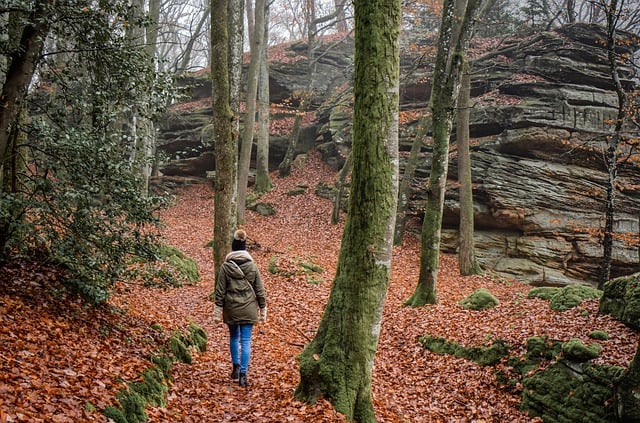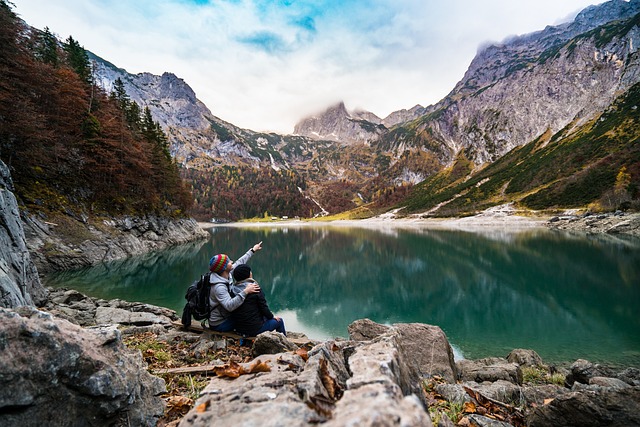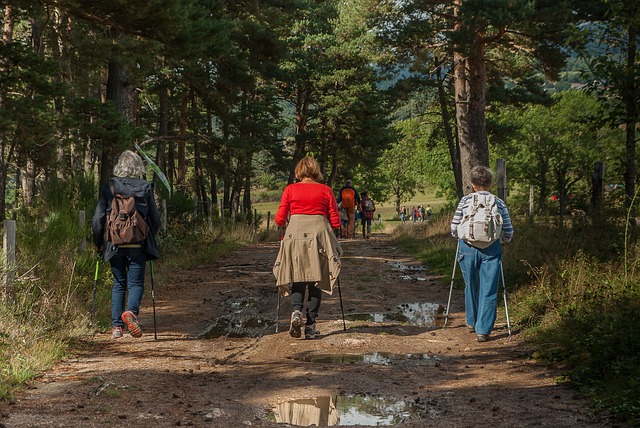
When venturing into the fog-laden paths of mountain trails, choosing a flashlight specifically designed for hiking trails is crucial. The ideal flashlight should be durable, with impact and water resistance to endure rugged terrain and weather changes. It must feature high-intensity LED lighting to penetrate through mist, with adjustable brightness to extend battery life without compromising visibility. Advanced models come with additional features such as specialized lenses or filters for reduced glare, headlamp options for hands-free operation, and emergency modes like strobe or SOS signals. Accessorizing your flashlight can further enhance performance and safety, ensuring a secure and enjoyable hiking experience even in challenging conditions. Flashlights designed for hiking trails are essential tools for outdoor enthusiasts who wish to navigate with confidence and ease on foggy mountain excursions.
When venturing into the fog-shrouded peaks, the right flashlight becomes a beacon of safety and clarity. This article illuminates the critical role reliable lighting plays on misty mountain trails and guides you through selecting the best flashlights for hiking trails. We’ll explore key features that ensure visibility, delve into battery life considerations to keep you illuminated throughout your journey, and analyze the anatomy of a durable flashlight built for outdoor endurance. Additionally, we’ll discuss techniques for optimal lighting and accessory options to enhance your mountain hiking safety. Prepare to traverse the clouds with confidence, as we shed light on what it takes to brighten your path in the looming mists.
- Understanding the Importance of Reliable Lighting on Foggy Mountain Trails
- Key Features to Look for in a Flashlight for Hiking Trails
- Top-Rated Flashlights for Foggy Conditions and Mountain Hikes
- Battery Life Considerations: Ensuring Your Flashlight Lasts the Distance
- The Anatomy of a Durable Flashlight: Materials and Design for Outdoor Use
- Techniques for Effective Lighting on Foggy Trails to Maximize Visibility
- Accessorizing Your Flashlight: Attachments and Modifications for Enhanced Mountain Hiking Safety
Understanding the Importance of Reliable Lighting on Foggy Mountain Trails

When traversing mountain trails shrouded in fog, the role of a dependable flashlight becomes paramount for hikers and outdoor enthusiasts. The dense fog that often blankets these trails can drastically reduce visibility, making it easy to misstep or lose the path altogether. Flashlights for hiking trails are designed with high-intensity outputs to cut through the mist, ensuring that users can navigate their surroundings safely. A reliable flashlight not only illuminates the immediate area but also alleviates the psychological discomfort associated with being in a potentially disorienting environment.
The importance of selecting a high-quality flashlight cannot be overstated; it’s an essential tool for maintaining situational awareness on such trails. Flashlights for hiking trails often feature durable construction to withstand the elements, as well as various light modes to conserve battery life when maximum brightness isn’t necessary. Additionally, features like water resistance and impact-resistance are crucial in ensuring that the flashlight remains operational even in harsh conditions. By investing in a flashlight specifically engineered for hiking trails, outdoor adventurers can enhance their safety and enjoyment of their foggy mountain journey, turning an otherwise challenging situation into a manageable and enriching experience.
Key Features to Look for in a Flashlight for Hiking Trails

When selecting a flashlight for hiking trails, particularly in foggy mountain conditions, certain features become paramount to ensure safety and visibility. Durability is a key aspect; the flashlight should be built to withstand the elements, including water resistance and a sturdy construction that can handle drops or rough terrain. A high-quality, impact-resistant body is essential for long-term use on hiking trails where accidents can happen.
Light output and beam type are also critical considerations. Look for flashlights that offer a balance of both a focused beam for distant objects and a wider beam for close-up tasks. Adjustable brightness settings are beneficial as they allow users to conserve battery life on low light and maximize visibility when needed. Additionally, LED technology is preferred due to its longevity and energy efficiency. For foggy conditions, a flashlight with a high-quality lens that can cut through the mist will be especially valuable. Features such as a strobe function or red light modes can also aid in navigation, as these settings can help preserve night vision and signal for assistance if necessary. When hiking trails where visibility is compromised by fog, the right flashlight can make all the difference, enhancing both safety and the overall experience of the trail.
Top-Rated Flashlights for Foggy Conditions and Mountain Hikes

When venturing into the fog-laden trails of mountains, a reliable flashlight becomes an indispensable tool for hikers. The best flashlights for hiking trails in such conditions are those designed with advanced lighting technologies and features that enhance visibility in low light or complete darkness. High-quality LED bulbs offer a bright, focused beam that can pierce through the dense fog, ensuring you remain on the right path. Additionally, these top-rated flashlights often come with adjustable intensity settings, allowing users to conserve battery life when full illumination isn’t necessary and ramp up the light output as needed.
Durability is also a key factor; mountain trails can be unforgiving, with rough terrain and potentially hazardous conditions. Flashlights for hiking trails must be built to withstand such environments, featuring robust construction with non-slip grips and impact-resistant bodies. Waterproofing and a sturdy design ensure that these flashlights continue to function even when encountered with unexpected weather changes or when they are accidentally dropped. For those who often hike in foggy conditions, investing in a high-performance flashlight designed specifically for hiking trails is not just a safety measure—it’s an essential piece of equipment for a successful and safe mountain excursion.
Battery Life Considerations: Ensuring Your Flashlight Lasts the Distance

When embarking on a hike through foggy mountain trails, reliability and efficiency in your lighting equipment are paramount. Flashlights for hiking trails must be equipped with robust battery systems to ensure they provide sufficient illumination over extended periods. To maximize battery life during such excursions, it’s crucial to opt for flashlights that boast high-capacity cells complemented by energy-efficient LED technology. These advanced flashlights can offer lumen outputs that rival their incandescent counterparts while consuming significantly less power. Users should also consider the quality of the flashlight’s circuitry, as it directly affects power management and runtime. Features like automatic step-down lighting or low-power indicators can help manage battery life effectively. Furthermore, users must understand the estimated runtimes advertised by manufacturers, which are often based on the highest light output settings. It’s advisable to operate your flashlight at a lower brightness level when full visibility is not required, thus conserving power and extending its usability throughout your journey. By prioritizing these battery life considerations, hikers can ensure that their flashlights for hiking trails remain reliable companions, providing clear guidance and safety in the unpredictable conditions of foggy mountain trails.
The Anatomy of a Durable Flashlight: Materials and Design for Outdoor Use

When venturing into foggy mountain trails, reliability and durability of your flashlight are paramount. A durable flashlight designed for hiking trails is not just a tool but an essential companion that can ensure safety and comfort during your expedition. The anatomy of such a flashlight begins with its exterior materials; high-impact plastic or aircraft-grade aluminum are common choices due to their strength-to-weight ratios, offering both protection against falls and reducing the burden on your pack. These materials also provide insulation against extreme temperatures, which can be encountered in mountainous terrains.
The design of a flashlight for hiking trails must account for rough terrain and variable weather conditions, including fog. A robust construction with a textured grip prevents the light from slipping out of wet or sweaty hands. Nitrogen-purged seals protect the internal components from fogging up due to temperature changes, ensuring consistent light output when you need it most. Impact-resistant glass lenses shield the bulb inside, which is often a high-efficiency LED that offers bright, focused light with minimal battery consumption. Features like waterproofing and shock-absorbing end caps further enhance the flashlight’s performance, making it an indispensable tool for hikers navigating foggy mountain trails.
Techniques for Effective Lighting on Foggy Trails to Maximize Visibility

When navigating foggy mountain trails, the right lighting can be a game-changer for hikers. To maximize visibility and ensure safety, it’s crucial to use flashlights designed specifically for hiking trails, such as those with high-intensity LED technology. These flashlights for hiking trails provide a focused beam that cuts through the fog, illuminating the path ahead without causing discomfort or creating reflections that can obscure the environment. Hikers should consider adjustable brightness settings to conserve battery life when full luminosity isn’t necessary and to avoid temporarily blinding themselves or fellow hikers. Additionally, flashlights with a wide beam angle can help in identifying trail markers and potential hazards off to the sides.
Moreover, using flashlights for hiking trails with red or green filters can enhance visibility in low-light conditions. These colored lenses reduce the glare often associated with white light in foggy environments and allow hikers to see more clearly by adapting to the hiker’s night vision. It’s also beneficial to choose flashlights that are durable, waterproof, and have a secure grip, as conditions on mountain trails can be unpredictable. By employing these techniques and utilizing quality flashlights for hiking trails, hikers can navigate through fog with confidence, ensuring they maintain a clear path forward and reach their destination safely.
Accessorizing Your Flashlight: Attachments and Modifications for Enhanced Mountain Hiking Safety

When venturing into foggy mountain trails, having a reliable flashlight is crucial for your safety and comfort. To ensure optimal visibility and task performance during your hiking expeditions, consider accessorizing your flashlight with attachments and modifications tailored for such environments. For instance, a diffuser lens can spread the light beam over a wider area, which is particularly helpful when navigating through dense fog where distant objects might otherwise remain obscured. Additionally, attaching a red filter to your flashlight can significantly reduce glare and eye strain, allowing you to see more clearly in low-light conditions without compromising your night adaptation.
For those who frequently hike on these trails, investing in a headlamp with an adjustable band can provide hands-free illumination, enabling you to keep your balance and free your hands for other essential tasks like map reading or securing your gear. Furthermore, flashlights designed specifically for hiking trails often come with multiple settings, including strobe and SOS modes, which can be lifesavers in emergencies. A waterproof and shock-resistant model will ensure that your light source remains reliable even in the toughest mountainous terrains. By carefully selecting attachments and modifications for your flashlight, you can enhance your safety and confidence while hiking foggy trails, making each journey more enjoyable and secure.
In conclusion, navigating mountain trails under the cloak of fog can be a daunting task. A reliable flashlight is indispensable in such conditions, serving as your guide through the mist-shrouded landscape. The right flashlight for hiking trails must not only illuminate the path ahead but also offer robust construction, extended battery life, and effective light distribution. By considering key features like lumen output, beam type, and durable materials, along with accessories that enhance safety and functionality, hikers can ensure their visual journey through the mountains remains unobstructed. Whether you’re a seasoned adventurer or an occasional trekker, investing in a high-quality flashlight for hiking trails can make the difference between a safe return and an unsure step into the unknown. With the right tools and knowledge outlined in this article, you are now well-equipped to choose the best flashlight for your next mountain excursion, even when the fog rolls in.







